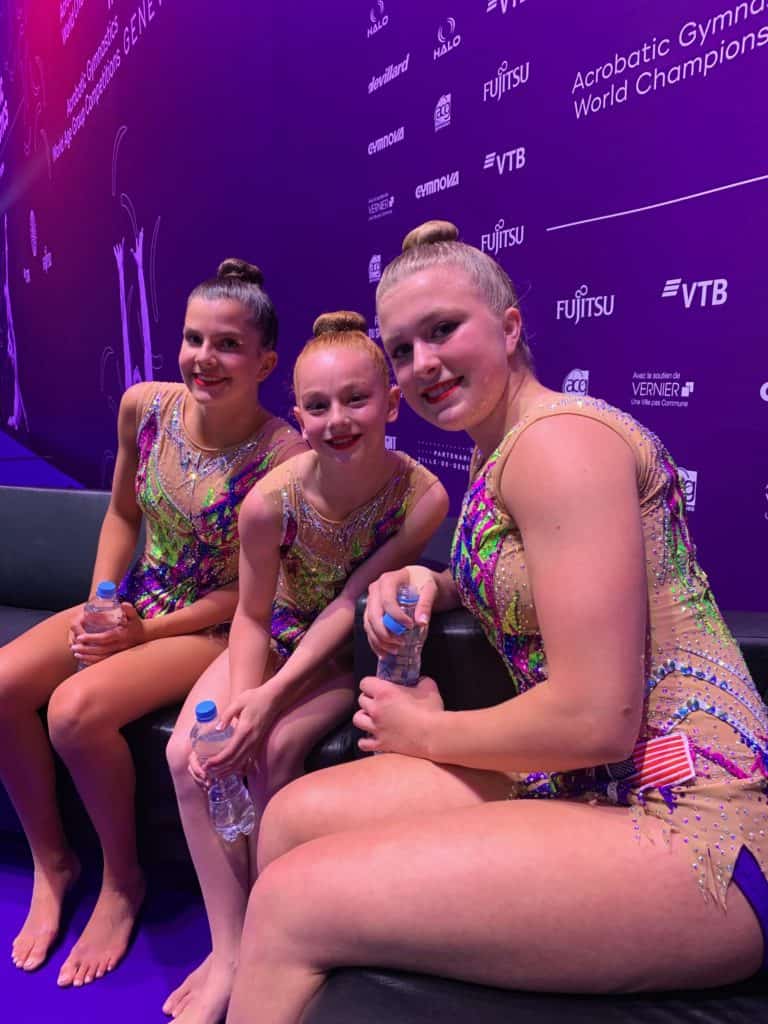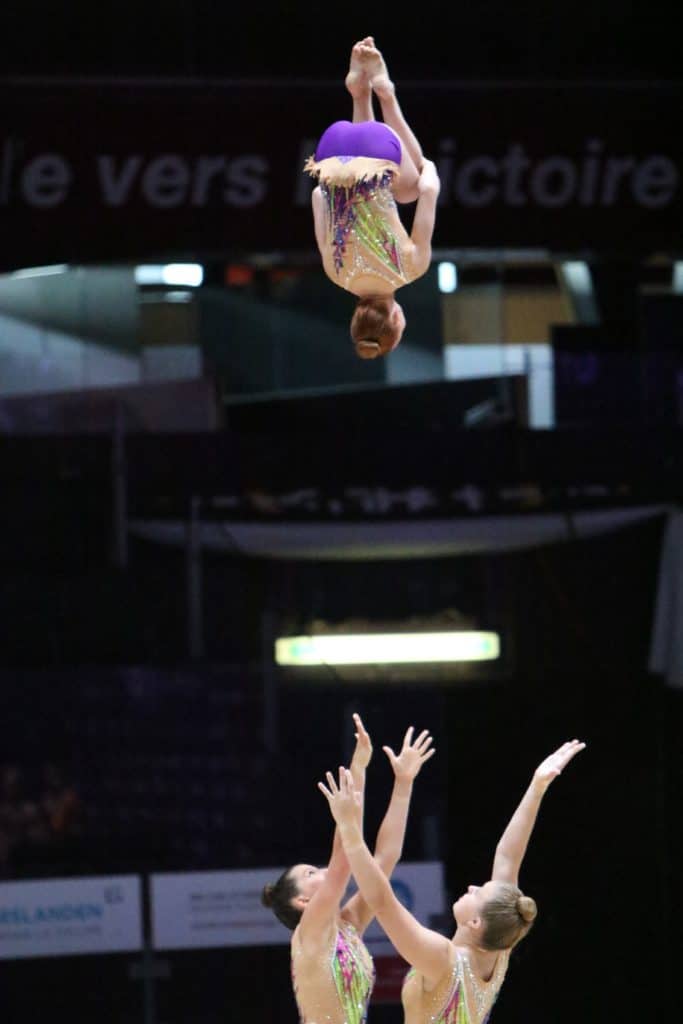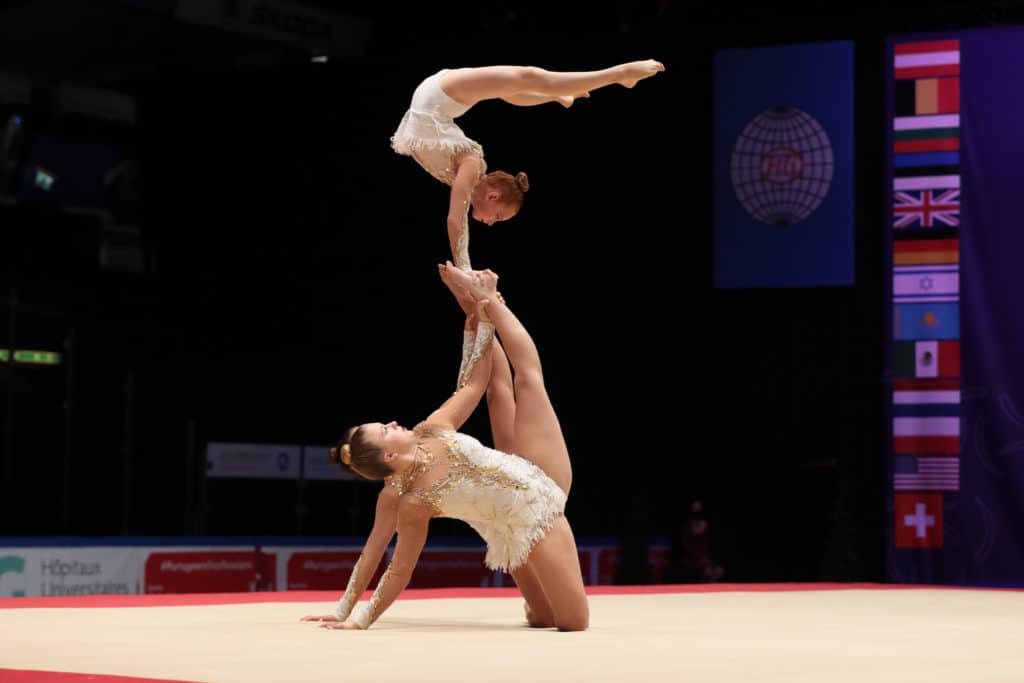From Backyard Tumbling to World Championships

Acrobatic gymnastics team wins big
By Kathy Knotts
There aren’t any parallel bars or balance beams. But a trio of local teen gymnasts are earning medals, trophies and accolades in the world of acrobatic gymnastics.
The Elite trio from International Elite Acrobatics in Crofton just represented the entire United States at the world championship in Geneva, Switzerland this month—and went on to earn seventh place in the world for their age group.
Sarah Wilson, Grace Wright and Gia Calo were selected as the Junior National Team in the 12-18 Age Group division by USA Gymnastics.
Acrobatic gymnastics differs from what you may have seen while watching the Olympics this week. Instead of competing in individual tests of strength, balance and flexibility, these young athletes share in their success by literally supporting each other, balancing each other and sending one of their team flying into the air and catching her every time.
The discipline relies on partnerships of gymnasts working together and performing choregraphed routines consisting of acrobatic moves, dance and tumbling, set to music.
“What you see in the Olympics are bars, beam, vault and floor competitions,” says Sarah Thomas, director of International Elite. “In acro, it’s all on the floor.”
Acro competitions consist of three types of routines: balance, dynamic, and combined. The athletes compete in pairs or groups. The smaller, more flexible and typically younger athletes are tapped for the top or “flyer” positions, while taller and stronger athletes are ideal for the base positions. On the International Elite team, 12-year-old Gia is the flyer and Grace, 16, and Sarah, 15, work as bases, depending on the routine.
A balance routine requires the team to build different types of pyramids and perform different holds, with the focus being on strength, poise and flexibility. “So for some of those skills, I am holding both Sarah and Gia up, on my feet,” explains Grace, a junior at Key School in Annapolis.

“The hardest balance skill to perform would be ‘foot to foot’ where I am laying on my back with my feet in the air, Sarah is standing on my feet with her arms above her head, and Gia does a press to handstand from a pike position.”
“I will be like standing on Grace,” says Sarah, “while holding Gia up above me.” Sarah will be a sophomore at St. Mary’s High School in Annapolis this year.
For a dynamic routine, the team known as the “Powerpuff Trio” because of their hair colors (one red, one blonde, one brunette), demonstrates skills of flight with somersaults and tosses and catches. “For dynamics, I’m the one they are throwing around” says Gia, who enters 7th grade at Severn River Middle School this fall. Grace and Sarah work together to throw their teammate in the air to perform lifts, twists and flips. They also are required to demonstrate tumbling individually during the routine. “Our hardest dynamic skills would be the scoop double layout which is where Gia stands on the floor and leans back, and Sarah and I push and throw her above our heads and she does two flips in a layout position, and lands on the other side of us,” explains Grace.
The third type of routine is combined, which includes elements from both balance and dynamic.
Elements of dance play a larger role in acro than in artistic gymnastics, where flourishes mainly serve as a transition point between skill demonstrations. Choreography and music help give an acro routine its own style and distinction, making the sport a pleasure to watch.
The trio says they have been watching Team USA compete in the Tokyo Olympics. “When I was really little my idol was Shawn Johnson,” says Grace. “After watching her I said ‘I want to go to the Olympics’ but then I got into acro and [going to] Worlds was that for me. I was also obsessed with Gabby Douglas.”
For Sarah Wilson and Gia, watching Simone Biles is a given but they are more into following athletes in their own discipline. “My acro hero is probably Emma Bentov-Lagman,” says Sarah Wilson. Bentov-Lagman is a former Elite athlete from their gym, who won Worlds medals in 2016 with her partners Cristin Connerney and Lily Dyer.
“I always saw them in the gym and they had super cool skills … they were super clean and I loved watching them and they were always very nice,” adds Sarah Wilson. “Emma’s trio was kind of that trio that you thought were perfect at the time and thought ‘I wanna do those skills’, and now we are doing that same thing.”

Director Sarah Thomas’ gyms have a long history of bringing home medals and trophies. Thomas herself has spent over 25 years in acrobatic gymnastics, serving as National Program Committee Chair, National Junior Olympic Chair, and winning National Elite Coach of the Year and National Star Service Awards.
“I grew up doing gymnastics but it was not my full-time job,” says Thomas. “But in 2001, I quit my day job as a senior marketing executive to move to Texas and coach full-time. I think my parents thought I was crazy for giving up such a high-level position. “
Thomas eventually moved back to Maryland and coached for over 10 years at 1st Class Gymnastics in Annapolis. “When the pandemic hit, 1st Class went out of business and at that point, I started International Elite. Starting a business in the middle of a pandemic was not ideal but I was determined to keep the team going to keep some sort of normalcy in the kids’ lives.”
The Elite team had previously won a silver medal in Great Britain when COVID-19 interrupted competition.
When the 2020 World Championship was postponed, the International Elite team saw an opportunity, albeit risky. “When it was canceled,” says Thomas, “the girls were not yet at the junior elite level. But then we made the decision to move them up. So basically, they went from an intermediate level and jumped up to elite in the course of like, eight months. It was a pretty big risk, a big jump from where they had been competing in the past. So COVID actually helped us get to a higher level I would say.”
The trio entered the trials for Worlds as the number 2 ranked team but ended up beating the first ranked team to advance. Only one team per country can compete in the world championship.
“Nerves are normal in competition but one thing we are really good at is controlling them and staying focused on what we need to do,” says Grace. “We keep everything—from our skills to how we talk to each other—normal, making it just how we do it in practice so we can to keep the stress level down and stay as calm and collected as possible.”
Grace says the waiting before competition at Worlds was the worst for her “because everything is quiet and we are just waiting, but the second we step onto the floor and the music starts, we block out the nerves and are in our zone ready to put everything we have worked so hard for out on the floor.”
Training for elite competition during a pandemic required some creative thinking, just as it did for the Tokyo Olympians. Gyms were closed and gatherings limited. “So we worked out in Sarah Wilson’s backyard,” says Thomas. “We kind of bubbled them together so they were only hanging out together. We put mats down in Sarah’s backyard and hoped it didn’t rain. It wasn’t easy to train outside of a gym, but we did what we could. We were shut down for probably four months.”
For all three athletes, training consists of workouts up to four hours a day. But they insist that they are having fun despite the intensity.
“I started gymnastics at like age 5,” says Sarah Wilson. “A coach from the acro team saw me and thought it would be good for me, and it’s been really fun. My favorite part is meeting people from around the country and the world and getting to travel. I love it. It’s a lot of work and a lot of commitment but it’s definitely worth it.”
Grace says the travel is a big plus. International Elite teams have competed in Portugal, Belgium, Poland, Germany, Switzerland, Great Britain, Italy, and Canada.
“I also love getting to do the ‘big’ skills,” adds Grace. “Even though it’s hard, I enjoy it so much. Yes, it is a lot of work and there’s a lot of sacrifice to go with it, but it’s definitely worth it. I honestly don’t know what I’d do with myself if I didn’t do acro.”
“I knew I wanted to be a flyer,” says Gia. “It looked really fun. And I’m having fun doing it.”
It’s this lighter side of a seriously determined group of young women that keeps their momentum going. “We all get along really well and work super efficiently together while still having lots of fun and laughing throughout practice,” says Grace. “We truly are like a family.”
“It’s a different kind of fun, because you are working really hard but then you have that payoff of going on the trips and reaching these really big goals so even though the training is more serious there is a bigger payoff at the end,” says Sarah Thomas.
Thomas currently has about 55 athletes on the team and has had World team members on the last five world teams. And she says “there are too many national champions and international medalists to count!”
The team is currently working on a new balance routine and developing some new skills for the season. While their sport may not be on the schedule at the Olympics, these elite athletes are still going for the gold on the international stage. Next up for the group is officially opening the new gym location in Crofton in September. They’re already preparing for the PanAm Games in November and the World trials in December with poise, power and precision.



